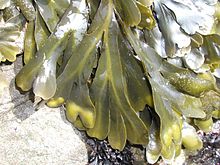Fucus gardneri
| Fucus gardneri | |
|---|---|

| |
| Scientific classification | |
| Domain: | Eukaryota |
| Clade: | Diaphoretickes |
| Clade: | SAR |
| Clade: | Stramenopiles |
| Phylum: | Gyrista |
| Subphylum: | Ochrophytina |
| Class: | Phaeophyceae |
| Order: | Fucales |
| Family: | Fucaceae |
| Genus: | Fucus |
| Species: | F. gardneri
|
| Binomial name | |
| Fucus gardneri P.C.Silva, 1953
| |

Fucus gardneri is a species of seaweed, a brown alga living on the littoral shore of the Pacific coasts of North America. It has the common names of rockweed and bladderwrack.
Description[edit]
Fucus gardneri is olive brown in colour and similar to Fucus spiralis. It grows to 40–50 centimetres (16–20 in) long and branches somewhat irregularly dichotomous and is attached, generally to rock, by a discoid holdfast. It has airsacks at the top.
Life history[edit]
The tips of mature individuals swell up and provide flotation for the plant as well as reproductive chambers for developing sperm and eggs. During low tide, the swollen tips dry up squeezing out sperm and eggs which unite into a zygote during the next flood tide and settle onto a substratum.
Ecology[edit]
Rockweed can form thick bands in the middle intertidal on rocky substrates.[1] The other common species of Fucus: Fucus spiralis, Fucus vesiculosus and Fucus serratus along with Ascophyllum nodosum form the main and dominant seaweeds on rocky shores. These three species, along with two others Pelvetia canaliculata and Ascophyllum nodosum form the zones along the shore.
Uses and history[edit]
Native Americans historically harvested the dried swollen tips of Fucus gardneri – sometimes referred to as "Indian pop corn". When the airbubbles are popped, it secretes a thick lotion, very moisturizing.[citation needed]
References[edit]
- ^ "Rockweed on Rocky Shoreline Photo". Archived from the original on 2014-04-26. Retrieved 2014-04-25.
Further reading[edit]
- Blanchette, Carol Anne (July 1997). "Size and Survival of Intertidal Plants in Response to Wave Action: A Case Study With Fucus Gardneri". Ecology. 78 (5): 1563–1578. doi:10.1890/0012-9658(1997)078[1563:SASOIP]2.0.CO;2.
- Colvard, Nicholas B.; Carrington, Emily; Helmuth, Brian (September 2014). "Temperature-dependent photosynthesis in the intertidal alga Fucus gardneri and sensitivity to ongoing climate change". Journal of Experimental Marine Biology and Ecology. 458: 6–12. doi:10.1016/j.jembe.2014.05.001.
- Edwards, Kyle; Pfister, Catherine; Can Alstyne, Kathryn (22 August 2006). "Nitrogen content in the brown alga Fucus gardneri and its relation to light, herbivory and wave exposure". Experimental Marine Biology and Ecology. 336 (1): 99–109. doi:10.1016/j.jembe.2006.04.013.
- Henry, Brianne; Van Alstyne, Kathryn (June 2004). "Effects of Uv Radiation on Growth and Phlorotannins Infucus Gardneri(Phaeophyceae) Juveniles and Embryos". Journal of Phycology. 40 (3): 527–533. doi:10.1111/j.1529-8817.2004.03103.x. S2CID 86384687.
- Ruuskanen, Ari T.; Nappu, Niko P. (16 February 2005). "Morphological differences in Fucus gardneri between two shores with equal cartographic exposure values but different levels of wave action". Annales Botanici Fennici. 42 (1): 27–33. JSTOR 23726813.
- Williams, Susan L.; Dethier, Megan N. (September 2005). "High and dry: Variation in net photosynthesis of the intertidal seaweed Fucus gardneri". Ecology. 86 (9): 2373–2379. doi:10.1890/04-1569.
- Wright, J.T; Williams, S.L; Dethier, M.N (June 19, 2004). "No zone is always greener: variation in the performance of Fucus gardneri embryos, juveniles and adults across tidal zone and season". Marine Biology. 145 (6): 1061–1073. doi:10.1007/s00227-004-1399-2. S2CID 84376519.
- Van Alstyne, Kathryn L.; Pelletreau, Karen N. (November 2000). "Effects of Nutrient Enrichment on Growth and Phlorotannin Production in Fucus Gardneri Embryos". Marine Ecology Progress Series. 206: 33–43. Bibcode:2000MEPS..206...33V. doi:10.3354/meps206033.
